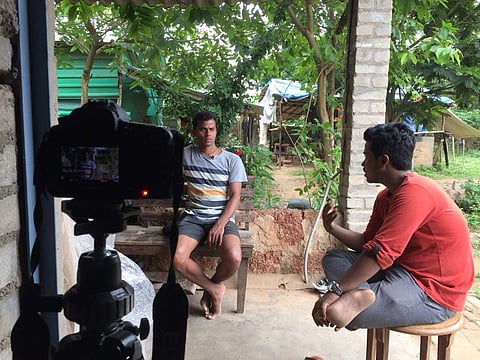

Krushi Bhavan is a testament to farmers and their fierce work, standing tall in Keshari Nagar, Bhubaneswar. It houses the Government of Odisha's Department of Agriculture & Farmers' Empowerment, the first floor of which was worked on by the artisans of Collective Craft, a studio that works with artisans and craftsmen to develop various products and projects. Just like this 1,30,000 sq ft administrative centre brings together artisans, farmers, the government and is a public art of sorts (it won the People's Choice Winner at the AZ Awards 2020 in the Social Good Category and also became the first building from India to be featured in the prestigious international architectural journal, Dezeen), independent filmmaker Abhishek Parija's documentary Whose Dreams? Whose City? brings together all of them and asks many burning questions. How are the artisans of the state doing? What do the farmers have to say about the building? Where do we find a public place in Bhubaneswar? And more importantly — Who made this city? Whose dreams does it entail? Who does it belong to? All of these are posed right at the beginning of the documentary itself. It is for us to determine the answers.
READ ALSO : This team of researchers from UoH has developed a first-of-its-kind Blockchain platform to aid farmers. We find out how it works
Grateful artisans who are glad to find work by the way of working on the building, a bureaucrat convinced of the cause they stand for, enraged farmers unleashing their fury, artists and many other voices find a platform in this balanced documentary that is a little less than 40 minutes long. Actually, it all started with Sibanand Bhol (Founder, Collective Craft and one of the producers of the documentary) extending Abhishek the opportunity to document the construction of the building. "But we knew that we wanted to do things our way, meaning, let the story's trajectory take us where it may," says the 25-year-old who wrote and directed the documentary while Sankalp Mohanty shot and edited it. It made sense to them that after they spoke to the artisans working at the building, one of whom point-blankly admits that if it wasn't for this, he would be a daily wage labourer, they would approach farmers and find out from them what they felt. A trip to Unit-1 Farmer's Market in Bhubaneswar and then to Dalabanapur (26 km from Bhubaneswar) followed and with it, some startling revelations.
What's striking is the section of the documentary where shots of the bureaucrats are intercut with that of a farmer, fuming over the shortcomings of the government. Then there is a comment about Chief Minister Naveen Pattnaik. Delving into these risqué scenes was not a concern for the duo. "That's because we have the advantage of being nobodies," shares Abhishek and laughs. On a more serious note, he adds, "What the government is saying they are doing is contradictory to what the farmers are saying. And this is not even a picture from the interior of the state, this was very much mainstream Odisha. The intercut wasn't a way to spice things up, there was simply no other impactful way to place it," he says reasonably.
The duo shot the documentary between 2018 and 2019 and it was ready by 2021, while they were pursuing their Master's in Jadavpur University, Kolkata. Shot on a Canon EOS 750D and a Canon EOS 5D Mark II, the duo would make weekend trips to Bhubaneswar to wind up the project as soon as they could. Tripods were borrowed when needed while the rest was mostly handheld work. But it was at the editing table when the real conundrum began. Since the documentary attempts to touch upon several sensitive topics, the question of what to keep was posed. "Though the logic is not off the mark, I do agree that there are several topics that we touched upon. Every documentary starts with a specific vision, but the film was offered to us in a certain way and we decided not to stick to that," explains the youngster who hails from Odisha and is a part of the Film Society of Bhubaneswar.
So, what was left out of the documentary? "If we had the space to say it, we would have liked to advocate for the training of individuals in craftsmanship at higher education level in design institutions and colleges with public funding. So that being an artisan can be a desirable profession. But that's in the hands of the state. At our end, what we would like to propose is that the working class must themselves organise and resist so that they can solve their own problems," says Abhishek, who is currently in Mumbai working as an Assistant Director and Sound Editor for an independent director, Karan Mirchandani. Some of the other thought-provoking aspects that the documentary delves into is what passes off as public art and how that idea has been influenced by the West, pushing artisans to make their traditional products more 'market-ready' and what we are losing in the bargain, plus the perils of the farmers and the artisans of this coastal state. A special mention goes to the original soundtrack by Keshav Iyengar, using the dotara and mridangam.
For the trailer, click on the following link youtu.be/4Au68a845nI
